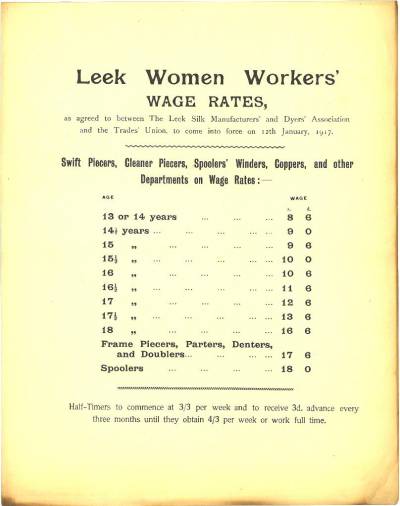Silk workers turned imported raw silk into thread, which was then woven to make silk.

Leek women`s wage rates 1917
Silk comes from the cocoon of the silkworm of the silk moth (Bombyx mori). It was very hard to breed silkworms in England as the temperature was too cold and the silkworms only ate the leaves of the mulberry tree, which did not grow here. Therefore raw silk was imported into England from China, India and Turkey to be made into thread and woven.
Silk weaving was introduced to England in the 17th Century by the Huguenots in Spitalfields, London. In the 18th Century people worked in their homes to make small silk items such as silk buttons and ribbons in places across the country including Macclesfield, Congleton and Leek. In the early 18th John Lombe opened the first silk mill in Derby with his newly invented silk spinning machine. During the 18th Century more mills were opened in other areas.
When steam power was introduced in the early 19th Century silk factories were established in many areas including Leek, Macclesfield, Congleton and Stockport. At these factories raw silk was processed into thread and then woven using machines.
There were many different jobs in silk factories including:
- Silk twister - spun raw silk
- Silk drawer - drew silk from silk waste for spinning
- Silk thrower/throwster - twisted silk into thread
- Silk piecer - joined the broken threads
- Silk dresser - prepared silk for weaving
- Silk dyer - dyed the silk
- Silk weaver - wove the silk
- Silker - sewed the ends of the fabric to prevent fraying
For information about silk workers' unions, click here.
For information about our silk workers' archives collection, click here.
Resources about silk workers in the library collection
John J Webb, Industrial Dublin since 1698 and the silk industry in Dublin: two essays (1913) - Shelfmark: G61
Mary Crozier, An old silk family 1745-1945: the Brocklehursts of Brocklehurst-Whiston Amalgamated Limited (1947) - Shelfmark: C06
Whately Cooke Taylor, The handbook of silk, cotton and woollen manufactures (1843) - Shelfmark: D28
Gail Malmgreen, Silk town: industry and culture in Macclesfield, 1750-1835 (1985) - Shelfmark: H19
W Henry Brown, The silken glow of Macclesfield - with the jubilee history of the Macclesfield Silk Manufacturing Society Limited / (1938) - Shelfmark: E24

